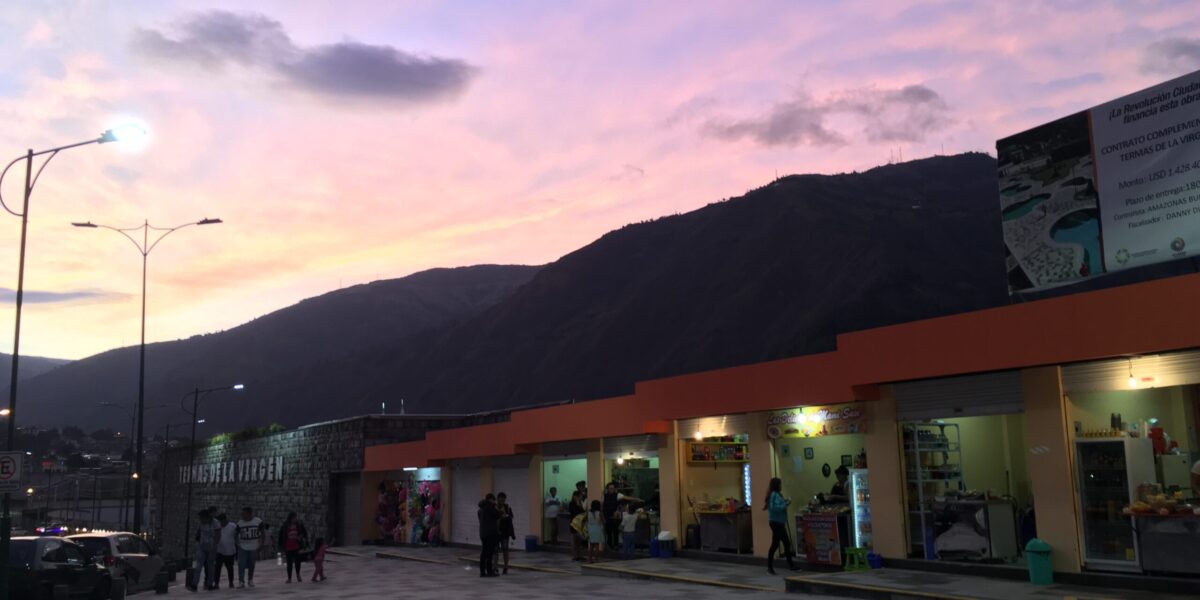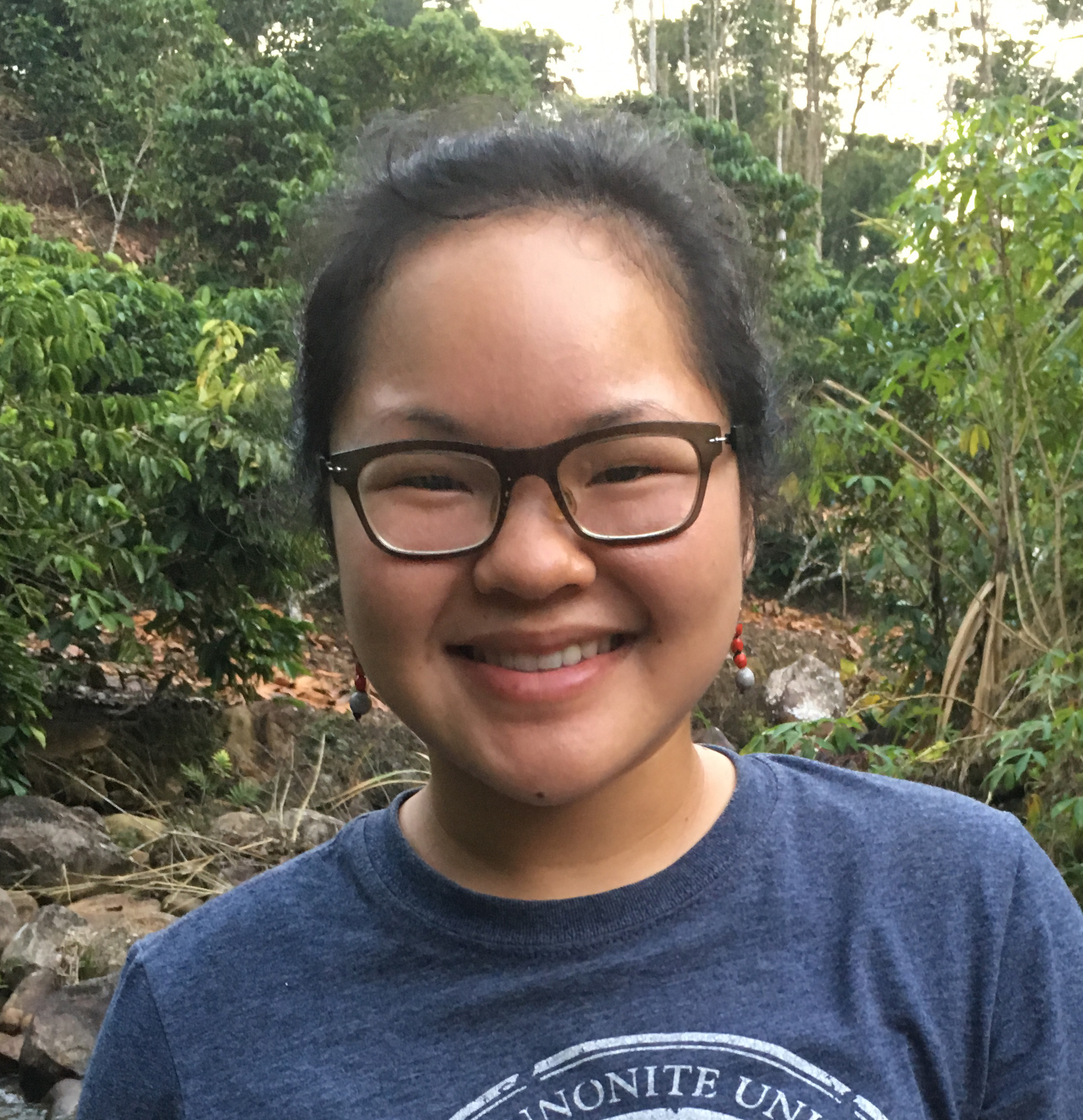Karina, Shannon, and I, along with a group from Goshen were led by the Ross Richer family as they introduced us to their life in Tena and Zábalo. Our trip was an incredible experience in the jungle getting to know the indigenous community, the Cofán, and some of the richest biodiversity in the world. The nearly two-week trip was full of new experiences, so I’ll try to give the highlights here with stories and pictures.
Day 1: We began our journey by traveling south from Quito, spending a night in the popular tourist city Baños. Baños" signifies the word "baths" in reference to the naturally-heated pools by the nearby volcanoes. Some of us enjoyed the baths while others explored the busy nightlife. Karina, Shannon, and I did the latter, indulging in many delicious street treats, such as chocolate-covered bananas, fresh caña juice, and hand-pulled taffy.
Homemade taffy in Baños.
Day 2: Arriving in the city of Shell, (named after the gas company that entered Ecuador in search of oil), our focus for this day was about the missionary presence in el Oriente, or the jungle region of Ecuador. We met with pastor and friend of the Ross Richer’s, Clever, who is from the Shuar indigenous group. Clever shared some profound thoughts from his perspective as an indigenous person who grew up in the rainforest and saw the not-always-positive impact of missionaries on his community. Missionaries constantly walk a fine line of being supportive in culturally appropriate ways. He also shared his vision for the support that missionaries can give to existing indigenous churches in the rainforest so that they can be sustainable and self-sufficient.
In the afternoon, we went to the Omaere Ethnobotanical Park, in other words, a plant nerd’s dream! In this guided tour, we learned about different trees and plants, their medicinal properties, and how indigenous people use specific plants to cook with, as medicines, to make art and jewelry, and to build their houses. We even had the opportunity to order a medicine directly from Omaere’s stock depending on various health concerns — and some people took advantage of this cheaper and natural option! On this day, I was thinking about God’s presence in the trees, how an unassuming little plant could help cure illnesses, and how plants and wildlife work together to create a functioning ecosystem.
Clever and Sofia present on the Christian missionary impact, both good and bad, on indigenous rainforest communities.
Day 3: We’ve arrived in Tena, and to the hot and humidity of the jungle! Tena is still a city, but the Ross Richers live on the outskirts. We visited their Kichwa neighbors, Cecilia and Lourdes, who showed us some of the kindest hospitality. To get to their house, we had to cross a shallow river and walk up a muddy path. However, the neighbors saw dusted the path, built handrails out of bamboo stalks, and decorated the path with flowers. The neighbors taught us how to make chicha, a typical drink that can be made from yuca or palm fruit. We used palm fruit called chonta, first cooking and peeling it, mashing it to a fine powder, and adding water. The mixture ferments for a few days and is then ready to drink. After the hard work of making the chicha, we enjoyed cacao blanco (white cacao) served on banana leaves while listening to the rain pour down through the open-aired house. In Tena, God worked through the hospitality of the neighbors who gave their time, energy, and food to teach us about their culture.
Helping Cecilia prepare the Chonta.
Day 4: Travel day to Zábalo. We began on our journey to Zábalo at an early 6am for about a seven-hour bus ride. We curved through the rest of the Andes and began to see more of the flat horizon, raised houses that protect from flooding, and beautiful tall trees with hanging birds nests. For our last part of the driving journey, we passed through many monocrops of African oil palm whose fruit is used as a bio-oil and in many food, cosmetic, and cleaning products. For the final part of the journey, we boarded a motorized canoe to embark down the Aguarico river, deeper into the jungle to arrive in Zábalo. It was a beautiful ride. Apparently, we arrived on record time — about two and a half hours when it normally takes about four. When we got there, the Ross Richer kids showed us the village, the popular spots being the soccer court and the river where the young people spend much of their free time. We then ate dinner and rested after a long day of travel.
With my boat buddy, Shannon.
Days 5-9: During our days in Zábalo with the Cofán, we spent time with people in their homes, exploring the jungle wildlife, and playing with kids. We were without internet and cell phone service, and were limited to power a few hours each evening when the generator was on for the whole village. This disconnection from the rest of the world helped connect more with people. Learning from people in their own homes was an important part of getting to know their stories and their lives as Cofánes. We spent an afternoon with Gladys learning how to make shigras, or woven bags. She makes her own string to weave shigras and hammocks. Another day, we learned how to make yuca bread with Irene. She showed us the whole process: harvesting, peeling, grating, drying, and cooking. Both making shigras and yuca bread are very labor-intensive process.
A hammock Gladys made.
Exploring the biodiversity was a dream come true for a wildlife lover like me! We took a guided hike through the forest walking amongst massive Kapok trees and the deafening sound of cicadas. It felt surreal to be seeing the things we had always taught about when I worked at the zoo. We also spent a full day traveling further down the Zábalo river, searching for wildlife in the trees and in the water. We turned the motor off for a couple of hours to just float, taking in whatever passed us by. I was in awe as I took in sights that before I had only seen in National Geographic magazines and nature documentaries. Three Cofán youth came with us and were always the first to spot something exciting. Throughout the day, we saw troops of wooly and squirrel monkeys, dozens of birds, caimans, and heard a freshwater dolphin!
View from the boat trip.
During the evenings, we would spend time with the kids. The older ones would play soccer while the younger ones and I would watch from the side. We would usually end up playing with bugs, flashlight tag, or the "poking game" which meant poking each other and running away with laughter and great joy. Even though I could not speak Cofán and many of the younger kids did not yet speak Spanish, we were definitely still communicating in other ways.
My favorite of these activities with the kids was swimming in the river — a perfect way to cool off in the humid jungle heat. The river is very important to those who live in the Oriente. Aside from leisure, people use the river to bathe, wash their clothes, as a mode of transportation, and to fish for food. However, the river is also unpredictable. It can change course over seasons, its path taking over where houses once stood. In the jungle, the river is in charge.
On Sunday, we went to church and met pastor Iter. The service was in Cofán, so I couldn’t really understand anything. However, that didn’t mean that I couldn’t sense God’s presence in other aspects of the service, such as in the way Iter led music with his teenage son, Charlie, or in the fact that young people make up the majority of the congregation most Sundays. God was definitely present in the high-pitched, yet perfectly in tune, 3-year-old Cofán voice coming from the back of the sanctuary. He probably did not understand all the words he was singing, but the spirit with which he sang moved me. Later in the afternoon, we met with Iter and his family to learn more about their story and their involvement in the church. He told us how he does not view himself as a pastor, but took the role because God changed his life, and he wants other people to see this possibility in theirs, and for the church to grow.
Pastors Iter and Irene demonstrating how to harvest yuca.
I will miss this beautiful community, but I will treasure the stories and experiences from the Cofán. I believe that God is working among the Cofán to support Iter as he navigates the challenges of creating a sustainable church community. God is also present among the symbiotic relationship between the Cofán and their environment; the Cofán care for and protect the plants and wildlife while the plants and wildlife provide food, shelter, and livelihood to the Cofán. We rose early again on our last day to head back up the Aguarico river, waving goodbye to Iter, Irene and their kids after a special time of prayer with them.
Irene teaching me how to cook the yuca bread.
Day 10: On our way back to Quito, we spend a night in Huaticocha, Ecuador, at the Ninawachi Institute. Ninawachi is a two-year Bible school where young indigenous adults live, take classes, clean, and volunteer in the community. The idea is that the students will share what they learn with other indigenous communities. The camaraderie and energy among the students was evident. It was fun to get to know them during the short time we spent there.
My time in the Oriente was an incredible experience. It is truly a different world there, and I know I’ve only seen a glimpse of it. As we return back to the city, I know I am returning from Tena, Zábalo, and Huaticocha a changed person with a greater respect for indigenous people all over the world.
















